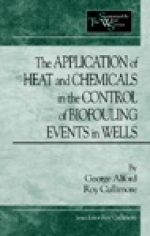Application of heat and chemicals to a biofouling well is a relatively new approach for water well rehabilitation.
For the first time, The Application of Heat and Chemicals in the Control of Biofouling Events in Wells explains what many microbiologists now believe is the most effective form of treatment: pasteurization and application of chemicals.
Consider an increasingly prevalent alternative to traditional forms of encrustation: an approach which recognizes that water wells are conduits to the sub-surface realm, whose organisms impact the production characteristics of wells.
Theoretical Perceptions of a Functioning Water Well
Introduction
Early Diagnostic Techniques for Failing Wells
Symptoms
Traditional Rehabilitation Techniques
Recognition of Biofouling-Intrinsic Concern
Recent Technological Advances
Theoretical Appraisal: Causes of Biofouling
Major Symptoms of Biofouling
Plug Formation
Chronological Sequence of Symptoms in Plug Formation
Recalcitrant Chemical Accumulates
Compromised Water Quality
Production Failures
Appraisal of the Causes of Biofouling
Major Symptoms of Biofouling
Plug Formation
Chronological Sequences
Water Production
Biofouling Process
Critical Indicators: The Stages of Biofouling
Chemical Indicators Reflecting Biofouling
Physical Factors Influenced by Biofouling
Biological Factors Influenced by Biofouling
Application of Heat and Chemicals in the Control of Biofouling Events in Wells
Application of Heat, Background Information
Historical Aspects of the Application of Heat
Clogging
Plugging
Bioplugging
Pasteurization of Water Wells
Blending Chemicals With Heat Treatment
BCHT™ Developments
Upper Woods River, 1988
Brookville Lake, 1990
Shaw Air Force Base, 1992
Garrison Dam, 1992
Leesville, 1992
Bofors Site, 1993
Mississippi River, 1993
Conclusions, 1988 to 1993
Revisions and Retrofitting, Bringing Down the Cost
Introduction
Application of Jetting
Selection of a Suitable Heat Source
Problems: Heat and Chemical Applications
Successful Rehabilitation of Relief Wells
Risk Assessments and Environmental Impact
BCHT™ Treatment
Applications Protocol
Hazardous Waste Sites
Hot Versus Cold Treatment
Diagnosis of Biofouling Wells
Preventative Maintenance
Targeting the Biofouling
Hazardous Waste Sites
Well Biofouling
Historical Background
The Coliform Problem
Good Record Keeping and Monitoring Performance
Preventive Maintenance, The Essential Component
Discussions
Questions and Answers
Summary
Final Comment
TITANIC, the Connection Between Rusticles and Clogging
Appendix Definition of Terms
Selected Bibliography
Index

























